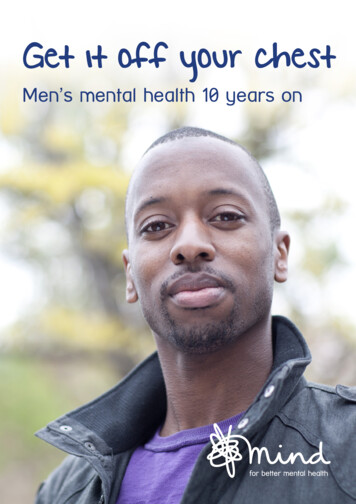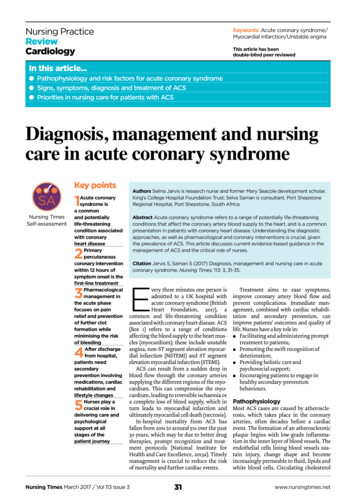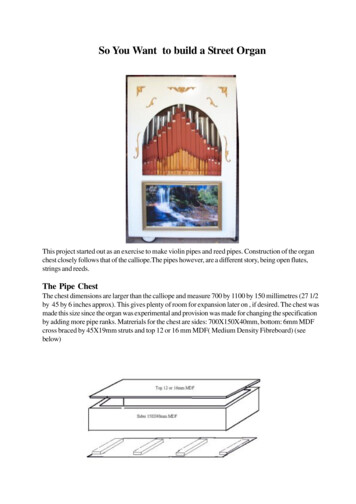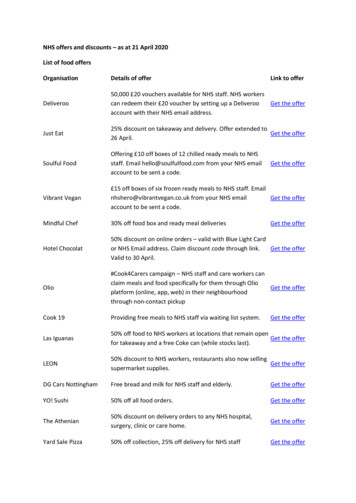
Transcription
Get it off your chestMen’s mental health 10 years on
ContentsIntroduction.3Key findings.4Research findings:Setting the context of men’s mental health. 6Prevalence of mental health problems. 6Suicide rates in men. 6Accessing the right support. 8Help-seeking behaviour. 8Accessing services. 9Alternatives to medication.10Coping mechanisms .11Social support: family and friends.11Criminalising men’s mental health: ‘acting out’ and diagnosis.12Factors impacting on men’s mental health.13Work and unemployment.13Physical appearance.13Social media.14The mental health impact of existing inequalities on certain groups.15Black, Asian and Minority Ethnic men.15Gay, Bisexual & Trans men.17Men’s mental health in midlife.18Recommendations.20References.222Get it off your chest: men’s mental health 10 years on
IntroductionIn 2009, Mind published ‘Get It Off Your Chest’,a report which drew on YouGov polling dataand focus groups to understand the challengesfacing men’s mental health. Ten years on,we’re interested in how the changes in both thecultural climate and men’s attitudes have affectedthese challenges and how this compares to theexperiences of women. Particularly now, in lightof the outbreak of the coronavirus (Covid-19)pandemic, the rise in prominence of the BlackLives Matter movement and a predicted economicdecline, it is important to make use of thisresearch to inform the development of futuresupport for men’s mental health.In September 2019 Mind re-commissionedYouGov to repeat the survey of over 2,000men and women, asking about their experiencesof mental health and seeking support, to findout how people’s experiences have changedsince 2009.This report draws on findings from these twosurveys, as well as new focus groups carriedout by local Minds (Sheffield Mind, Bristol Mindand Mind in Harrow) looking specifically at men’smental health and help seeking behaviours. It alsodraws on findings from the most recent researchavailable to understand the wider context formen’s mental health today.Black, Asian and Minority Ethnic groups,and LGBTQ people are underrepresentedthroughout the sample in our YouGov surveys.This report therefore brings together researchfrom a variety of other sources to understandhow mental health is affected amongstthese groups.The findings show that there have been someimprovements in men feeling able to seek helpfor their mental health, however, this comes incontrast to an increase in the amount of menexperiencing mental health problems. It is clearthat while some progress has been made,with the development of the Five Year ForwardView for Mental Health, NHS Long Term Planand the National Suicide Prevention Strategy,among other initiatives, there is more to be doneto ensure that men feel able to access mentalhealth support that both suits their needs andideally provides early intervention.We have therefore made a series ofrecommendations, based on the findingsset out in this report, for the UK Government,employers and the health, education andsocial care sectors, to positively effectchange across men’s mental health.Get it off your chest: men’s mental health 10 years on3
Key findingsTwo in five men(43%) admit to regularly feelingworried or low, an increase from37% in 2009Over athird ofmen37%(37%) say social media has anegative impact on how they feelThe number of menwho have suicidalthoughts when feelingworried or low hasMen are still more likely thanwomen to10%doubled to 10%since 2009One in ten menreported getting angry whenthey are worried, a drop of 5%since 20094Get it off your chest: men’s mental health 10 years ondrink alone, go to thepub with friends, ortake recreational drugsto relax when feeling worriedor downMen’s preferred alternatives tobeing prescribed medication areface-to-facetherapy andphysical activity
Men are now almostThe number of men who arethree timesworried abouttheir appearancemore likely to seea therapist whenworried or low thanin 2009has risen from 18% in 2009to 23%Men are nowequally aswilling aswomen tosee their GPif they feel worried or low – a largeincrease since 2009Thenumber ofmen whosay thatnothing would putthem off finding helpif they were feelinglow has decreasedby almost a fifthsince 2009Men would bemore likely to seek supportif they felt worried or low if it was madeavailable online, if they were guaranteedanonymity, or if help was made available atmore convenient times of dayGet it off your chest: men’s mental health 10 years on5
Setting the context of men’smental healthPrevalence of mental health problemsOver two in five men (43 per cent) admitted toregularly feeling worried or low compared to 53per cent of women. This is an increase of 6 percent for men since 2009. While more women saythey regularly feel worried or low, the numberof men feeling worried or low has increased atdouble the rate of women over the last decade.While reported levels of common mentalhealth problems, such as anxiety or depression,are lower among men (13.2 per cent of mencompared to 20.7 per cent of women),1 it iswidely thought that this represents a considerableunderestimation of true need. Men’s problemsmay manifest themselves differently fromwomen’s; their symptoms sometimes gounrecognised and undiagnosed and they donot receive appropriate treatment. Men havealso recorded lower levels of life satisfactionand feeling that “the things done in life areworthwhile” and have reported higher levelsof anxiety since monitoring began in 2011.2We are also beginning to see the impact of thecoronavirus pandemic on the prevalence ofmental health problems. Samaritans recentlyfound that 42% of men said that pandemicrestrictions have had a negative impact on theirmental health.3 The most recent data from the6Office of National Statistics (ONS) suggests thatalmost one in five adults (19.2%) were likely tobe experiencing some form of depression duringthe coronavirus pandemic in June 2020; this hadalmost doubled from around 1 in 10 (9.7%) beforethe pandemic (July 2019 to March 2020).4From our own research, we know that peoplewho were already struggling with their mentalhealth or with related issues like problems withemployment, housing, benefits and debt, havebeen hardest hit by coronavirus.5 However, theONS data also shows how the pandemic hasaffected people who were previously well andare now experiencing depressive symptoms forthe first time.Suicide rates in menWhen asked to choose three things that tend tohappen when they are worried or feeling low,alarmingly, the number of men who have suicidalthoughts has doubled to 10 per cent since our2009 poll. The number of women who havesuicidal thoughts when worried has increasedmore than threefold but is still lower than menat 7 per cent (up from 2 per cent in 2009).Over the last decade, there has been a steadyoverall reduction in suicides in the UK, until 2018when there was a significant increase in the rate,the first rise since 2013.6 The Office for NationalStatistics (ONS) reported that this was largelydriven by an increase among men, as well asthe lowering of the standard of proof required torecord a death as a suicide, which came in partway through the year.7 Three-quarters of deathsregistered as suicide in England and Wales in2019 were among men (4,303 deaths), which hasbeen the case since the mid-1990s.8
The male suicide rate in England and Wales in2019 of 16.9 deaths per 100,000, was consistentwith the rate in 2018 but represented a significantincrease from the rate in 2017. Men aged 45 to49 years had the highest age-specific suicide rate(25.5 deaths per 100,000 males versus 11.0 deathsper 100,000 for the general population).The reasons behind suicides are complex, butSamaritans has found that deprivation, financialinsecurity and unmanageable debt are stronglyassociated with an increased risk of suicide inmen.9 Research has also found that two-thirds ofadults aged 16 to 64 in receipt of Employment andSupport Allowance (ESA) have a common mentalhealth problem (66.1 per cent),10 and almost halfof people claiming ESA have made a suicideattempt at some point.11We welcome the focus onpreventing suicide in men in theNational Suicide PreventionStrategy and national guidance forlocal authorities, as well as via the 25 million in funding for NHS Englandfor suicide prevention and the FiveYear Forward View for Mental Healthcommitments to reduce suicide by10 per cent. We would like to see theUK Government commit to a new targetfor reduction of suicides beyond 2021,supported by the necessary resourcesto achieve it and specific targets forreducing suicides in men.Get it off your chest: men’s mental health 10 years on7
Accessing the right supportHelp-seeking behaviourOur research in 2009 found that men wereconsiderably less likely than women to seeksupport when they were worried or feeling lowfor more than a couple of weeks. While thereasons for this may be complex, traditionalmasculine values such as self-reliance andstoicism are likely to play a role, with talkingabout mental health seen as a weakness. Menalso told us that the services available to themwere not male-friendly or tailored to their needsand that practical issues such as opening timesand the location of services were a barrier togetting help.From childhood boys are told to keepquiet about emotions and that mendon’t talk to each other It becametiring and I became very withdrawn.I felt forced to conform.Mark, Mind in Harrow focus group participantWe asked men for the top three reasons thatwould stop them seeking help if they were feelingworried or low for two weeks or more. Since2009 we have seen only a 3 per cent decreasein the number of men who say that feelingembarrassed was a top reason (down to 28 percent). This has also dropped 5 per cent forwomen (to 21 per cent), so while a gender gappersists, it is narrowing.In 2019, 10 per cent of men said that the fear ofbeing told they were mentally ill would be in theirtop three reasons likely to stop them seekinghelp, versus 6 per cent of women believing thesame. Stigma presents an additional barrier toseeking help and stigmatising attitudes andbehaviours are more pronounced among men.Research from Time to Change found that menare less knowledgeable about mental health andhold more negative attitudes. They are far lesslikely to report their own experiences of mental8health problems or discuss mental healthproblems with a professional. They are also morelikely to say that mental health problems are theresult of a ‘lack of self-discipline and willpower’.12Pressure for me to be ‘masculine’started at a young age with my familyand carried on when I went to schooland then work I was always told to‘man up’.Jay, Mind in Harrow focus group participantAlthough there’s been a 1 per cent drop since2009 in how likely men are to talk to theirpartner when worried or low, they are nowmore likely to take positive steps such as: look for information (up 10 per centin 2019) see their doctor (up 12 per cent in 2019) talk to their family (up 5 per cent in 2019) talk to a friend (up 5 per cent in 2019) find a therapist or counsellor (up 11 percent in 2019) buy a self-help book (up 4 per cent in 2019)Despite these positive shifts there has beena slight increase in men who say that one of thetop three reasons likely to put them off findinghelp is that they wouldn’t know where to start(up 3 per cent in 2019). This suggests that whilethere is increased awareness about mentalhealth, more targeted mental health promotion inthe community and online is needed, so that menknow where to find help. 16 per cent of men listed‘fear of being put on medication’ in the top threereasons likely to deter them from seeking help,which was a 2 per cent increase from 2009,showing this is still a concern for many.Additionally, the number of men who say thatGet it off your chest: men’s mental health 10 years on
What would make it easier to seek help?When asked what would make it easier to seek help if feeling low or worried for a while, menchose the following:25%20%15%10%5%0%22%15%12%11%6%5%Support andinformationavailableonlineAn assuranceof anonymityHelpavailableat moreconvenienttimes of dayAvailabilityof help atplaces otherthan GPsurgeryHelpavailableover thephoneSupportavailable atwork or atjob centresnothing would stop them seeking help hasdecreased by almost a fifth since 2009, from22 per cent to 18 per cent.While these figures are encouraging and suggestthe gap in willingness to seek help might beclosing, ultimately men are still less likely to seekhelp from the NHS for a mental health problemthan women.Accessing servicesIn 2009 there was a large gap between men andwomen’s willingness to see their GP if they feltlow for more than two weeks, with only 23 percent of men saying they would be likely to,compared to 33 per cent of women. This timeround, 35 per cent of both men and women saidthey would be likely to consult their GP. Men alsomade up 31 per cent of callers to Mind’s Infolinein 2018/19, up from 25 per cent in 2009/10.This may reflect that notions of masculinity areslowly starting to change, as it becomes moreacceptable to ask for help. In part, this could bedue to an increased awareness of mental healthin society and the media, with more positive andvaried portrayals starting to normalise mentalhealth problems. Targeted awareness and antistigma campaigns aimed at men, such as Timeto Change’s ‘In Your Corner’ and ‘Ask Twice’campaigns may have also contributed positively.17 per cent of men said they would be likely togo to a counsellor or therapist to talk about theirfeelings if they were feeling worried or low fortwo weeks or more, as opposed to 22 per cent ofwomen. In 2009 our survey showed men werealmost half as likely as women to seek help froma counsellor or therapist (6 per cent of mensought help versus 11 per cent of women). Thisis in keeping with men making up only 35 percent of those accessing Improving Access toPsychological Therapy (IAPT), the NHS’s talkingtherapies service for people with mild to moderatemental health problems such as anxiety anddepression.13Men who took part in a focus group in Sheffieldtold us that for them, the problem was not askingfor help but help not being available. Despitemore investment in mental health services overrecent years, only 39 per cent of people with acommon mental health problem get any supportat all.14Get it off your chest: men’s mental health 10 years on9
As the NHS Long Term Plan isrolled out, the NHS must deliveron its commitments to widenaccess to mental health servicesand monitor whether men are accessingservices in proportion to their needs.There also needs to be a choice ofservices available, and local areas shouldconsult with men to ensure servicesmeet their needs.Alternatives to medicationWe asked men to imagine they’d been feelinganxious or low for a while and were seeinga GP for support. When asked, as analternative to medication, what support theywould prefer, they said: Face-to-face therapy (30 per cent) Physical activity (17 per cent) A social activity (12 per cent) Online therapy (6 per cent) Peer support (6 per cent) Group therapy (2 per cent)When asked to choose their top two preferencesfor prescribed treatment if they had been lowor anxious for more than two weeks, the mostpopular answers were: Counselling (40 per cent, up from 23 percent in 2009)There’s good evidence to suggest that at mostages, for both men and women, being moreactive is linked to a trend for lower rates ofdepression. In fact, one study has found that byincreasing your activity levels from doing nothingto exercising at least three times a week, youcan reduce your risk of depression by up to30 per cent.15Mind’s Get Set to Go programme, funded bySport England and expanded with support fromthe EFL (English Football League), helps peoplewith mental health problems to get more active.In its pilot phase participants felt it improved theirresilience and their ability to deal with anxiety,panic attacks, and even suicidal thoughts.16The University of Essex carried out researchfor Mind, which found that 94 per cent of peoplewho took part in outdoor exercise activities,like walking or even gardening, said that greenexercise activities had benefited their mentalhealth.17 In fact, ecotherapy – activities thattake place in nature – can be as effective asantidepressants in treating mild to moderatedepression.18As part of the NHS Long TermPlan, NHS England has pledgedthat by 2023/24, 900,000 morepeople will have access to socialprescribing. This is a golden opportunityfor men with mental health problems toaccess alternatives to traditional clinicalservices which will support their mentalhealth. This could include physicalexercise on prescription, walking groups,gardening groups, or learning activities. Exercise (29 per cent, up from 23 per cent in2009). Men are also more likely than womento exercise at the gym to cope with feelingworried or down (14 per cent v 9 per cent). Self-help (24 per cent similar with 25 percent in 2009) Time off work (22 per cent, up from 15 percent in 2009) Antidepressants (16 per cent, up from 10 percent in 2009)10Get it off your chest: men’s mental health 10 years on
You tend to find that people whosuffer with mental health problemswill struggle in environments wherethere’s a lot of people around andnoise. So, they actually go where it’sa little bit quieter because they’vealready got a busy mind that’stormenting them every second ofthe day, so they try and connectwith natural beauty by goingoutdoors and going to the parksand out in the Peak District.health problems, who are more likely thanthe general population to have substancemisuse issues.People with a dual diagnosis ofmental health problems andsubstance misuse need to be ableto access holistic support that meetsall of their needs. The UK Governmentshould increase funding to localauthorities for public health to enablegreater investment in substance misuseservices, smoking cessation, as well asmental health prevention and promotion.Sheffield Mind focus group participantSocial support: family and friendsCoping mechanismsMen are more likely than women to useunhealthy coping mechanisms when feeling lowor worried, including drinking more alcohol (15per cent v 10 per cent), smoking more (7 per centv 6 per cent) and taking recreational drugs (2 percent v 1 per cent). When asked to choose threeways they most like to relax when feeling worriedor low, men are also more likely than women todrink alone (13 per cent v 9 per cent), go to thepub with friends (13 per cent v 6 per cent), ortake recreational drugs to relax (4 per cent v1 per cent).Around a third of men in 2019 (34 per cent) wouldbe likely to talk to their friends about theirproblems if they were feeling worried or low fortwo weeks or more, compared to just over half ofwomen (52 per cent). This is an increase of 5 percent among men and a decrease of 2 per cent forwomen, in comparison to 2009. It fits with ourunderstanding that male friendships are oftenbased on shared activity, such as going to thepub or attending sport, rather than sharing theirfeelings and worries, while women are morelikely to confide in their friends when they arefeeling low.20When asked the three things they would be mostlikely to do if a male friend confided in them thatthey were worried or low, men are now lesslikely than they were 10 years ago to take thatfriend to the pub (down from 29 per cent in 2009to 22 per cent in 2019).Sometimes men will self-medicate with alcohol ordrugs as a way of coping with a mental healthproblem. Men are twice as likely as women todrink hazardously and are much more likely tohave drug dependency issues in the generalpopulation.19 People with a dual diagnosis, or asubstance misuse and a mental health problem,often find it difficult to access mental healthservices and find themselves excluded fromsupport. Additionally, cuts to drug and alcoholsupport services in the community have adisproportionate impact on people with mental11
For men in relationships, their partners are oftenthe major source of emotional support, with oursurvey finding that 51 per cent of men would belikely to talk to their partner if they felt worried orlow for two weeks or more.Just over a third of men (36 per cent) wouldtalk to their family about feeling low, comparedwith 43 per cent of women. This is an increasefor men of 5 per cent (31 per cent in 2009) anda decrease of 4 per cent for women (47 per centin 2009), again suggesting the gap in behaviourbetween men and women is narrowing.Criminalising men’s mental health:‘acting out’ and diagnosisThe more ‘feminine’ symptoms are recognisedwithin mental health assessments while men’ssymptoms are more likely to bring them intocontact with the criminal justice system. The latestfigures in 2018 showed that men made up 95 percent of people in prison21 and a further 90 percent of people on probation.22While aggressive or violentbehaviour is never acceptable,there need to be clearerdiagnostic principles in recognisingmental health problems that mayunderpin aggressive or violent behaviourin men to ensure appropriate supportis given.When asked to choose three things that tend tohappen when they are worried or feeling low,one in 10 men said they get angry when theyare worried, compared with 8 per cent of women.This is a 5 per cent drop for men and womencompared to 2009.When experiencing a mental health problem,many men reported that they will externaliseor ‘act out’ their symptoms through disruptive,violent and antisocial behaviour. By contrast,women reported that they are more likely to‘act in’, with mental health problems manifestingas low self-esteem, feelings of guilt andreduced concentration.12Get it off your chest: men’s mental health 10 years on
Factors impacting on men’smental healthWork and unemploymentPhysical appearanceOur previous survey was launched at the heightof the financial crisis and at the start of arecession. Economic growth has remainedsluggish for the last decade, and whileunemployment has remained low, there has beena growth in the gig economy,23 characterised byprecarious short-term and zero hours contracts.The percentage of men who are worried abouttheir appearance has risen from 18 per cent in2009 to 23 per cent. Worries seem to be greatestin 18–24 year olds (39 per cent) and 35–44 yearolds (36 per cent). Overall, 6 per cent of men saidsocial media made them worry about how theylook, but this was much higher among 18–24 yearolds at 19 per cent, falling to 12 per cent of 25–34year olds and 9 per cent of 35–44 year olds.Despite this, the percentage of men currentlyworried about money has fallen from 45 percent to 38 per cent over the decade. Meanwhile,despite workforce changes, only 20 per cent ofmen were worried about job security comparedwith 27 per cent in 2009, and 18 per cent ofwomen were worried compared with 22 per centin 2009. These figures are, however, likely toshift significantly as we enter another recession.This is particularly true for men already facinginequalities, who are likely to suffer a greaternegative impact on their mental health broughtabout by economic uncertainty.Mind recently surveyed people with mental healthproblems to see how the pandemic had affectedtheir mental health. The resulting data, from morethan 14,000 people aged 25 and over, found thatconcerns about employment and finances weresome of several worries that had a negativeimpact on people’s mental health, with 45 percent of men saying that employment worries hadnegatively affected their mental health and 41 percent claiming their mental health was made worseby concerns about finances.24My mum and dad told me, when Iwas a kid, when you used to go out ona date, it might be someone you’d metin the pub, it was a friend of a friend,or people used to put adverts out fordates and stuff like this. Now you’vegot the likes of Tinder, all thesedifferent social media platforms,where in a split second, you arecompletely judged on exactly howyou look, right? Now, it’s as simpleas that, it’s a yes or a no. There’s nogetting to know someone anymore.Sheffield Mind focus group participantWhile having concerns about your physicalappearance isn’t a mental health problem,it can be linked to poor mental health, eatingproblems, over-exercising and, in some cases,steroid misuse.25 A survey by the Mental HealthFoundation found that social media was oneof the key factors that affected the way peoplefeel about their appearance.26Get it off your chest: men’s mental health 10 years on13
Social mediaWhile schools can play a role insupporting young people to usesocial media safely, there is also aneed for evidence-based advice onusing social media for adults.According to our survey, 37 per cent of mensaid social media had a negative impact on howthey feel, and interestingly this varied with age,demonstrated in the graph below. 15 percent ofmen said they would be happier if they usedsocial media less and 4 percent also say socialmedia makes them feel vulnerable because youcan experience abuse online. However, thesefindings also varied between age groups.Social media and the online world can be a usefulsource of information, peer support and digitaltools to manage mental health, however there arealso risks around misinformation, cyberbullying,promoting unrealistic body images and idealisedlifestyles. Many online experiences are designedto be addictive which can interfere with otheraspects of life including people’s sleep patterns,while a culture of ‘likes’ can be damaging toself-esteem.27What we’ve created is a world wherewhat is false now becomes realbecause if you can get as many likeson social media, it all of a suddenbecomes a statement of fact.Sheffield focus group participantThe mental healthFeeling on social media by age group5 0%4 0%3 0%2 0%1 0%0%44%19%Age 18–247%48%27%6%45%Age 25–34“Social media has a negaitive impact on how I feel”“I would be happier if I used social media less”“ Social media makes me feel vulnerable because youcan experience abuse online”Get it off your chest: men’s mental health 10 years on9%Age 35–44Key:1421%38%13%4%Age 45–54
Impact of existing inequalities oncertain groupsBlack, Asian and Minority Ethnic menBeing Asian, my experiences inschool and outside society differedfrom my experiences within thefamily. Traditionally in Asian culture,the expectation is that the man has aresponsibility to look after his familyand when my wife became pregnantI felt I needed support to adjust. Thepressure to be the main breadwinnerwas intense. There was no supportavailable for me to help me copewith the changes.Michael, Mind in Harrow user involvement groupThe Black Lives Matter movement has throwna spotlight on the inequalities faced by Blackpeople, as well as people from Asian and MinorityEthnic (BAME) groups*. These inequalities areacutely visible within a mental health context.Mind worked with a steering group of BAMEpeople, which informed our submission to therecent Independent Review of the Mental HealthAct, the legislation under which people can be* Mind recognises the limitations and problems of usingcatch-all umbrella terms such as ‘Black, Asian and MinorityEthic (BAME)’. We are always open to being challengedand are committed to doing better when it comes tounderstanding and addressing matters of discriminationand privilege. In order to make conclusions which can onlybe drawn from a robust sample size, for the purposes ofpresenting the findings of this research we have includedrespondents from different ethnic groups which fall underthe BAME umbrella. However we recognise that there aredistinct and unique identities and challenges facing differentcommunities referred to as ‘BAME’, which can be obscuredin research that aggregates non-White groups together as‘BAME groups’.detained for mental health treatment. The grouphighlighted the importance of recognising the roleracism plays, not only in service delivery, but alsoas a significant factor in why so many peoplebecome unwell in the first place.28 Experiences ofracism include both interpersonal and
Get it off your chest: men’s mental health 10 years on 3 Introduction In 2009, Mind published ‘Get It Off Your Chest’, a report which drew on YouGov polling data and focus groups to understand the challenges facing men’s mental health. Ten










